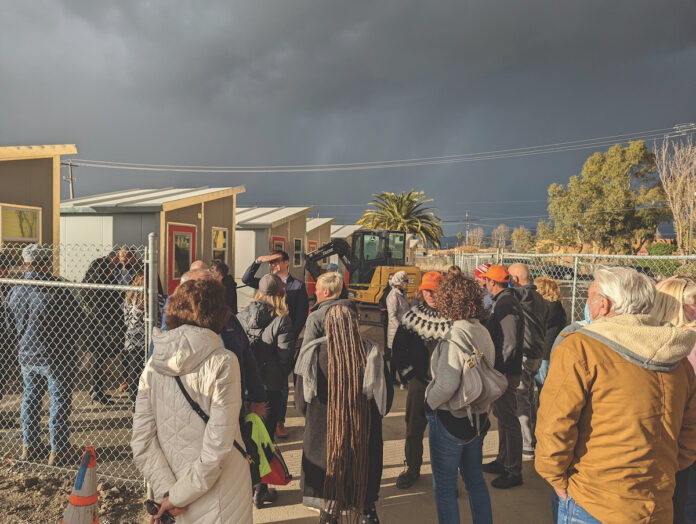On Feb. 22, the City of Petaluma held a ribbon-cutting ceremony for a strip of tiny houses.
The dwellings, the result of a partnership of COTS and the County of Sonoma, are temporary living spaces intended to help transition people into permanent housing and are called the People’s Village.
COTS shelters 190 people, according to its website. Some of them will be among the first to have access to the soon-to-be 30 little structures lined up next to the Mary Isaak Center.
Still, the 30 residents who will be housed in the tiny homes are a small slice of the nearly 300 residents officially experiencing homelessness in Petaluma. At a Steamer Landing encampment the day of the ceremony, I came across a man eagerly unpacking a brand-new tent, a donation he had received, he said, “from the County, I think.” That turned out to be incorrect.
I asked Mark—a pseudonym—about the People’s Village and, like the others I spoke with, he had heard of it, but not by name. He expressed worry about the ability of the government to address homelessness. I asked him what a solution might look like.
“It’s gotta be somewhat like what they’re doing through tiny houses; I think maybe it’s just a space that sticks longer than just, like, 6 weeks and then you gotta get out of here. Then you are just playing whack-a-mole,” Mark said.
Later, a couple arrived carrying two more of the brand-new tents. Former residents of “the Park,” as the people here call Steamer Landing, Reily and Nok will soon be moving into an apartment in Santa Rosa. They had organized the donation of the tents and were delivering them. “… We’re going to continue helping,” Nok said.
When I asked about the People’s Village, they were not happy.
“They are only, like, human-height [inside]. Really?” Reily said with a defiant tone.
“They look that tiny,” Nok added.
“You don’t have a bathroom or sink in there, or kitchen. That’s not fair,” Reily said. Noting that the most vulnerable members of our community are often experiencing physical or mental health issues, he added, “Everybody out here who has a disability should be treated a lot better than they are.”
Across midtown, hidden away along the river, is a very different encampment. Unlike the ragged temporary shelters of Steamer Landing, this camp, known to its residents as the Field, or the Little Field, has stood for perhaps five years. No simple tents here, but walled structures of plywood and tarps filled with furniture and personal items.
The two men I found there invited me into the camp. We sat together on a couch in what they called the “community center.” One of the men, Josh, apologized as he cleared loose items, saying, “All artists’ rooms are messy.”
When I asked about the People’s Village, the other man, Jordan, said he had just heard about it that morning.
“What are the stipulations on living there?” he asked, before thinking aloud. “I’m sure you have to be somewhat getting your shit together, doing something productive, so it’s gonna benefit yourself. [O]bviously they can’t give everybody a tiny home, so, I mean, you [must] have to give some incentive or do some sort of work or something, I feel like, to get that.”
“So you guys are feeling good about that being an option?” I asked.
“Yeah. As long as the City wants to help out homeless people,” Josh said.
“It’s cool they’re doing something besides just kicking people out of homeless spots. That doesn’t solve the problem,” Jordan said, “[which is] just passing the buck, homeless people are going to still be [somewhere].”
“It’s a small step,” he added. “Maybe it might be a piss in the ocean, but at least it’s a step in the right direction.”











